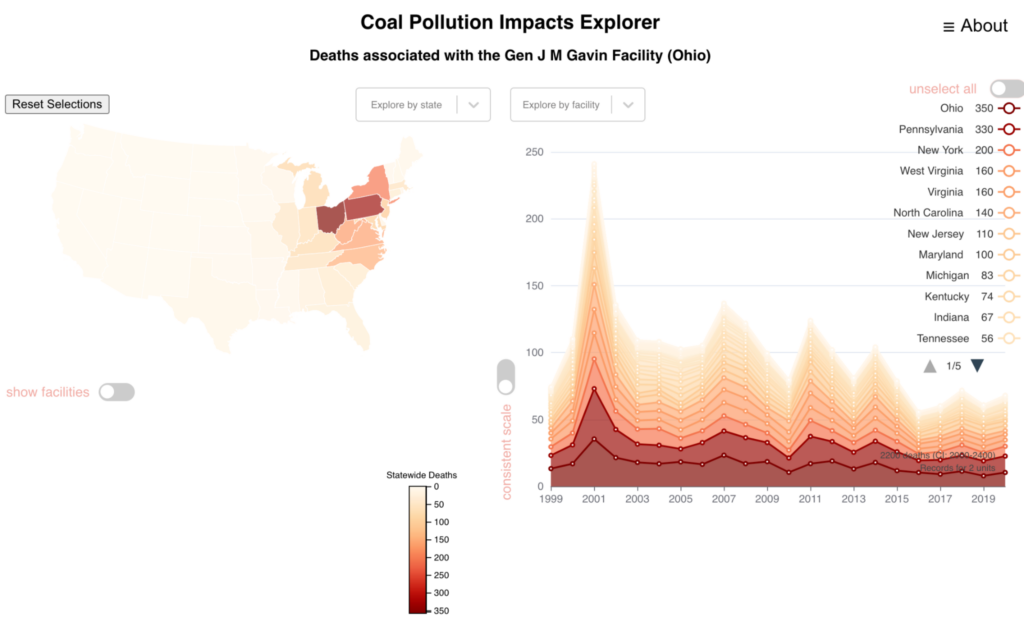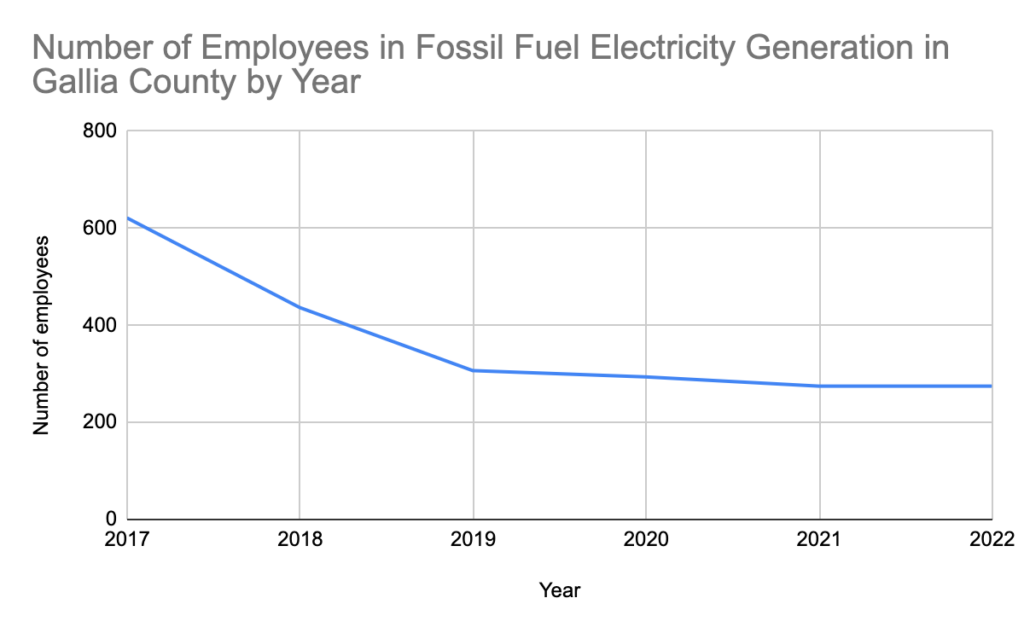
Community and health impacts of the coal-fired Gavin Power Plant
February 21, 2025
As Bridgepoint-owned Energy Capital Partners moves forward with purchasing the 50 year old General James M. Gavin Power Plant, investors should be aware of multi-state, ongoing negative health impacts associated with the coal plant. Modeling by the Sierra Club from 2023 shows that the Gavin Power Plant is one of the highest-emitting coal-fired power plants in the U.S., contributing to the premature deaths of 244 people per year, yet Energy Capital Partners has stated that it intends to keep the plant in operation in recent filings at the Federal Energy Regulatory Commission (FERC). As the Gavin coal plant continues to operate, it leaves a trail of negative health impacts across the northeastern United States, from Illinois to New Jersey and New York to Florida.
A $20 million buy out and then a $2.1 billion private equity deal
Today, Cheshire, Ohio, the location of the coal plant, is a relative ghost town thanks to a $20 million buy out by previous plant owners, American Electric Power (AEP.) For years residents had complained of headaches, burning eyes and sore throats. As reported by The Columbus Dispatch, archival documents recorded “milky droplets, soot and white specs from the plant’s exhaust.” Even after AEP spent millions of dollars on scrubbers and other technology to try to curb emissions, residents still complained of a “blue plume,” raspy throats, burning eyes, mouth blisters, and grime. In 2002, AEP bought out the town of Cheshire for $20 million in a settlement agreement that stipulated that in exchange for the money, Cheshire residents could not sue AEP for health impacts.
In 2017, AEP sold the Gavin Power Plant, along with three other plants, to a joint venture between private equity firms Blackstone and ArcLight called Lightstone for approximately $2.1 billion. Seven years later, in September 2024, Energy Capital Partners filed an application with FERC to acquire the Gavin Power Plant and the three additional power plants in Ohio and Indiana. The sale is currently pending FERC approval. Several organizations including Public Citizen, Sierra Club, and Private Equity Stakeholder Project have submitted a protest in this proceeding, seeking further information about the details of the transaction. A December 2024 response from Energy Capital Partners indicated that it expects that “the Gavin facility (and the facilities owned by the other Lightstone Public Utilities) will continue to operate for so long as they are legally able to do so on an economic basis.”
National health impacts of the Gavin Power Plant
The Gavin plant is the most deadly coal-fired power plant in the U.S. according to 2023 analysis by the Sierra Club which estimated that the Gavin coal plant was responsible for 244 premature deaths per year. It estimated that 51 of these annual deaths were in Ohio. 193 deaths were downwind from the coal plant, along the path of the pollution plume extending to the Eastern Seaboard. The pollution plume carries deadly particulate matter from the Gavin coal plant through the air for hundreds of miles. The Gavin Power Plant was responsible for an estimated 2200 excess deaths from 1999 to 2020 with the highest mortality rates in Ohio, Pennsylvania, New York, West Virginia and Virginia. In addition to premature death, the plant caused severe health impacts from New York state to Florida.

Graphic source: Sierra Club, Coal Pollution Impacts Explorer
According to a 2010 report by the Clean Air Task Force, “Among all industrial sources of air pollution, none poses greater risks to human health and the environment than coal-fired power plants.” A statement from the Sierra Club accompanying its 2023 report describes the effects of the pollution from burning coal: “Soot, also known as particulate matter, is a deadly mix of metals, organic chemicals, and acidic substances released into the air we breathe every time we burn fossil fuels.” A peer-reviewed study from a team of researchers from six universities found that the emissions of coal power plants are almost twice as harmful as originally thought. Coal-fired power plants emit fine particulate matter (PM2.5) that contains sulfur dioxide which is associated with 2.1 times higher mortality rates than other forms of PM2.5. While deaths associated with coal-fired power plant emissions decreased upon the installation of scrubbers, coal-fired power plants were responsible for 460,000 excess deaths in the U.S. between 1999 and 2020.

Graphic source: Sierra Club, Out of Control: The Deadly Impact of Coal Pollution
Gavin Power Plant water contamination
In June 2024, the U.S. Federal Court of Appeals upheld the EPA’s coal ash rule which would regulate the coal ash ponds of the Gavin Power Plant. Coal ash ponds contaminate local groundwater supply and can leech arsenic and other toxic chemicals into the drinking water supply. During an investigation by the EPA in 2022, one of the unlined coal ash ponds at the Gavin plant, the Fly Ash Reservoir, was found to have waste sitting in groundwater, with inadequate monitoring systems. It was estimated that there could be as much as 8.2 million cubic yards of coal combustion residuals saturated with groundwater (Gavin Power, LLC v. United States Environmental Protection Agency, Case No. 23-1038, Document #1986478. Exhibit A, page 20 (D.C. Cir. 2023)).
Declining coal power plant jobs in Gallia County
Since the purchase of the Gavin Power Plant by private equity firms Blackstone and Arclight in 2017, employment in Gallia County in fossil fuel generated electricity has decreased by almost two-thirds. In 2017, fossil fuel generation accounted for 621 jobs in Gallia County and by 2022 that number decreased to 274. Gallia County is located in the southeastern corner of Ohio and has a population of approximately 29,220, according to 2023 U.S. Census data. As of 2023 the employment rate of the county is 51.9% and the poverty rate was 14.8%. In Ohio overall, the employment rate was 60.8% and the poverty rate was 13.3%. 35% of employed individuals in the county work in educational services, health care and social assistance, 12.7% in manufacturing and 9.7% in retail. Only 8.2% of workers are in transportation, warehousing and utilities jobs, a portion of which includes remaining positions at the Gavin Power Plant.
While there are a variety of reasons for the decline in fossil fuel energy production jobs in the region, it is clear that coal-fired power plants are no longer the job creators they once were. Not only that, according to research from a researcher at the Georgia Institute of Technology on the lifespans of fossil fuel generating plants, the typical lifespan of units like the two at Gavin is 50 years, which end in 2024 and 2025 respectively, calling into question the future of the plant.

Graph created using U.S. Census employment data
While Gallia County may still be seen by some as coal country, the political appetite for subsidizing coal-fired power plants may be waning in Ohio. Gallia County is home to two coal-fired power plants: Kyger Creek and the Gavin Power Plants. The Kyger Creek Power Plant is owned by the Ohio Valley Electric Corporation and has been racked by a recent scandal where Ohio electric ratepayers are subsidizing this unprofitable power plant due to the passage of Ohio House Bill 6. HB 6 is currently caught up in a federal investigation of whatU.S. Attorney David DeVillers described as “the largest bribery, money laundering scheme ever perpetrated against the people of the state of Ohio.” The political tides on these subsidies may be turning. Ratepayer advocates and environmental activists have spoken out against these subsidies and now Ohio Governor Mike DeWine, who originally signed the coal-fired power plant subsidies in HB 6 into law, advocated that these subsidies be repealed.
It is time to retire Gavin
While once seen as a local economic powerhouse, the Gavin coal plant is now leading the way as one of the most deadly coal plants in the nation. It’s time to shut Gavin down, clean up the mess, and invest in a clean energy transition. Investors should call on Energy Capital Partners and Bridgepoint to create a plan to close this coal-fired plant to ensure the health and wellbeing of communities across the United States and the people of Gallia County, Ohio.
